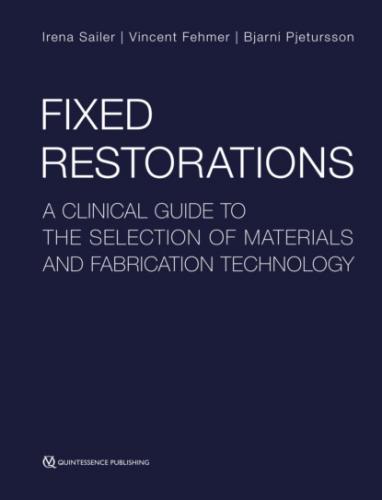Fixed Restorations. Irena Sailer
1-4-4e 3D printing of the mock-ups (reproduced from Sancho-Puchades et al16, with permission).
The procedures are illustrated step-by-step by means of the following clinical case:
A 52-year-old male patient asked for a comprehensive rehabilitation of his deteriorated dentition (Fig 1-4-5).
Figs 1-4-5a to 1-4-5c Initial situation of the patient; portrait, smile line, and intraoral frontal views of the dental situation prior to treatment (reproduced from Sancho-Puchades et al16, with permission).
His main concerns were to recover masticatory function and improve the appearance of his smile. After a thorough anamnesis and examination, the dental pathologies and the esthetic problems were identified. However, the diagnosis of the ideal contour of the prospective restoration needed further investigation. A wax-up was created and was tried-in as a direct mock-up over the patient’s teeth. The first diagnostics were discussed with the patient and the desired modifications were made in the diagnostic wax-up. Based on these corrections, eggshell provisionals were fabricated. With the provisional restorations, the patient’s initial desires were partially fulfilled since he could now comfortably eat again and his speech improved, but the patient was still not fully satisfied with the appearance of his new smile. Therefore, before the framework of the final restoration was designed another diagnostic try-in appointment was scheduled. The conventional master models were optically scanned (IScan D104, Imetric; Courgenay, Switzerland), and utilizing a virtual design software (Exocad, Exocad; Germany), three versions of the possible maxillary restorations were developed. The three versions were then printed in A3-colored resin (PolyJet MED610, Stratasys; Eden Prarie, MN, USA) using a 3D printer (Objet Eden 260V, Stratasys) (Fig 1-4-6a).
Fig 1-4-6a Different versions of the printed diagnostic mock-ups for this patient (reproduced from Sancho-Puchades et al16, with permission).
The digitally generated mock-ups were tried-in and critically evaluated by the patient and restorative team (Figs 1-4-6b to k).
Figs 1-4-6b to 1-4-6j Try-in of the different printed mock-ups (reproduced from Sancho-Puchades et al16, with permission).
It was agreed that the version with no diastema and converging incisal borders fit the best to the patient’s smile and face (Fig 1-4-7). This version was taken as a reference for the final restoration production.
Figs 1-4-7a to 1-4-7i Portraits with the different diagnostic mock-ups (reproduced from Sancho-Puchades et al16, with permission).
The .STL file of the selected version was integrated into guided surgery software and the implants were planned in the correct prosthetically oriented 3D position. After implantation and tooth preparation, the same .STL file was used for the fabrication of the final tooth- and implant-supported restorations with aid of a CAD/CAM procedure. By copy-pasting one design into each treatment phase, the predictability of the treatment was improved, as well as the efficiency of the entire treatment process.
Digital technologies offer significant improvement opportunities in many dental and medical fields. Restorative dentistry has been one of the disciplines that has profited the most from these technological advancements13. Among these innovations, CAD/CAM technologies have greatly influenced the production of provisional and definitive restorative components9,12,13. As the technology establishes and further develops (intraoral optical scanners, cast optical scanners, virtual design software, 3D printers), new indications rise in other treatment phases of the restorative workflow.
Despite the initial economic investment needed to create a digital workflow (software, scanners, printers), the current technical limitations of these rather recent technologies, and the learning curve required to master the virtual tools this pathway offers, the dental digitalization is an unstoppable phenomenon that will surely push the dental standards even higher. The incorporation of these technologies into the prosthetic diagnostic phase improves patient–clinician–technician communication without significantly increasing the treatment costs. This improves the predictability of the treatment outcome, one aim that is crucial in contemporary restorative dentistry.
1.4.6 Augmented reality in dentistry
Augmented reality is a versatile new digital technology applied in dentistry for guided implant surgery, preoperative planning in maxillofacial surgery, in orthodontics, and in endodontology. Yet, most interestingly it has opened up new horizons in restorative dentistry18.
New augmented reality tools were introduced which allow for dynamic virtual diagnostics, before the treatment is even started. As an example, an augmented reality application was recently developed, and is now available for iPad or iPhone. This app acts as a virtual-mirror-like tool which helps patients to identify their treatment needs and desires for improvement at a very early stage (eg, Ivosmile, Ivoclar Vivadent, Liechtenstein). By this the communication with the restorative team is improved, and before investing
